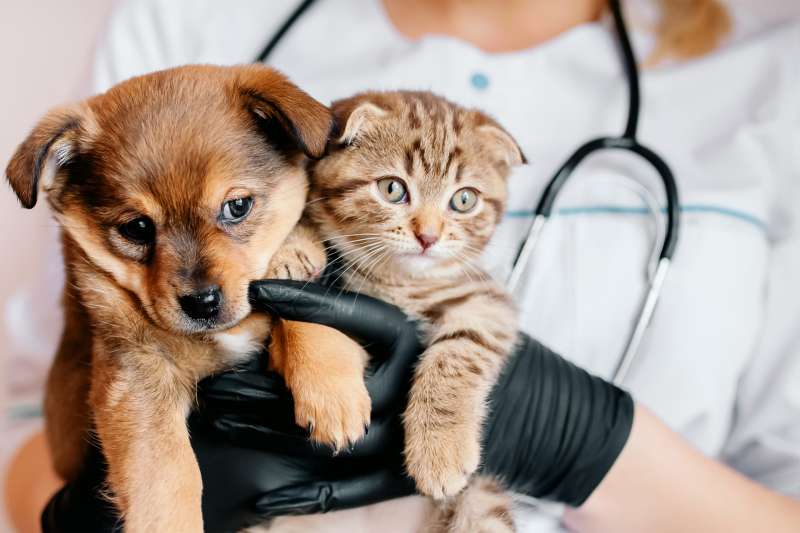Why Choosing a Higher Pet Insurance Deductible Can Pay Off

The size of deductible you choose for your homeowners and car insurance policies can hugely affect the premiums you pay. The same applies to pet insurance -- and can be a compelling reason to choose a high deductible rather than a smaller one.
When we surveyed pet insurance costs last year, we found the size of deductible — the amount you must pay out-of-pocket before the insurance policy kicks in and reimburses you a percentage of medical bills — to be among the biggest factors in determining the premium you'll pay. The higher the deductible you select, as a rule, the lower the premium you pay. Only the policy's scope (whether it covers only accidents, say, or also includes illness) and the pet's species (dogs consistently cost more to insure than cats) had a greater cost impact.
On average, we found you'll pay nearly $20 more a month by buying a policy with a $200 annual deductible rather than one that makes you responsible for the first $500 in charges. The savings nearly double — to about $35 a month — if you opt for a deductible of $1,000.
The range of deductibles available varies widely between insurers, and there are two main types of deductibles, too. Here are details on the deductibles offered, company by company, along with advice on how to decide on the deductible that suits your pet and your budget.
The range in pet-insurance deductibles
Pet policies typically allow you to choose a deductible of between $100 and $1,000. The most frequent options are deductibles of $250, or thereabouts, and $500. Outlying amounts can go as low as $50 or as high as $1,000.
Two companies we surveyed — Trupanion and TrustedPals — have a $0 deductible option, which allows reimbursements to begin immediately, and Trupanion allows you to select the deductible you wish, in $5 increments from $0 to $1,000.
Within any one company, though, the higher the deductible you choose, the lower your monthly premium, as a rule. Note, too, that policies also offer a choice in how much of the medical costs are covered after your deductible is met, with a higher percentage usually triggering a high premium. Popular choices include 70%, 80%, and 90% of those eligible expenses — which leaves you with co-pays of 30%, 20% and 10% of every vet bill, respectively.
Understanding deductible types
By far the most common type of deductible with pet policies is the familiar annual one. With this arrangement, you must, within a given policy year, pay the selected deductible amount out of pocket before the plan starts reimbursing you for veterinary services. The option resets every year, so each time the policy cycle renews you have to meet the deductible again.
All but one of the companies we researched for this story used this option. Trupanion alone offers per-condition — also known as per-incident — deductibles.
As the name implies, these involve a separate deductible for each condition for which the pet may require treatment — meaning you pay down a different deductible each time your pet goes to the vet for a different reason.
Another company with a unique deductible arrangement is Embrace, which rewards policyholders who do not make a claim. Embrace’s deductible diminishes over time, dropping by $50 for every year you go without filing a claim for covered care. The change does not itself increase the premium you pay — although keep in mind that pet premiums do typically rise over time as the animal ages, regardless of the policy deductible.
Pet-insurance deductibles, company-by-company
| Insurer | Deductible Type | Deductible Options |
| 24PetWatch | Annual | $100, $250, $500, $1,000 |
| ASPCA | Annual | $100, $150, $250 |
| Embrace | Annual | $200, $300, $500, $750, $1,000 |
| Figo | Annual | $100, $250, $500, $750 |
| Hartville | Annual | $100, $250, $500 |
| Healthy Paws | Annual | $250, $500 |
| Nationwide | Annual | $250 |
| Pets Best | Annual | $50, $100, $200, $250, $500, $1,000 |
| PetFirst | Annual | $50, $100, $250, $500 |
| Pet Plan | Annual | $250, $300, $500 |
| Pumpkin | Annual | $100, $250, $500 |
| Spot | Annual | $100, $250, $500, $750, $1,000 |
| Trupanion* | Lifetime per-condition | $0-1,000 in $5 increments |
| TrustedPals | Annual | $0, $100, $250, $500, $750 |
| Source: Money research, drawn primarily from insurers' websites in April 2021. Insurers are listed alphabetically and may not represent all companies that offer pet policies. * Trupanion plans in Florida have no deductibles. |
The case for choosing an annual deductible
According to Daniel Caughill, co-founder of The Dog Tale, annual deductibles are easier to understand and will likely be a better fit for most pet owners.
Per-condition deductibles require keeping track of what you’ve spent, condition by condition, in order to know if and when you’ll qualify for reimbursement. And with each new medical problem, you begin paying a different deductible — which could mean waiting longer for bills to begin to be reimbursed than if you only had a single, all-in-one annual deductible to meet.
On the upside, though, if your pet does develop an ongoing medical issue, you pay a per-condition deductible just once, and need never again pay a deductible for that condition for as long as you have the policy.
Let's compare the impact of the two deductible types when a pet has a chronic condition — say, for one such as diabetes that could require treatment costs of $2,500 over the course of a year. If you had pet insurance with a $500 annual deductible that reimbursed you 90% of eligible bills, you'd be reimbursed $1,300 and have to pay a total of $700 (the $500 deductible plus a 10% co-pay on the remaining bills).
The same expenses with a Trupanion policy that has a per-condition deductible of $500 would result in the same first-year costs. In subsequent years, though, you’d have no deductible left to meet — and would be reimbursed $2,250, which is 90% of the full treatment cost of $2,500.
That arrangement would save you nearly $1,000 a year, and might be more advantageous in the long run should your pet indeed develop an ongoing condition or require serious surgery. However, keep in in mind that the odds of those occurrences are relatively low. In addition, your actual pay-off would depend on the relative cost of premiums from Trupanion — which we do not currently rank as among the cheapest pet insurance companies. Also, the company has only a single reimbursement option, of 90%.
The case for going high on your deductible
As for the size of deductible, we suggest selecting the largest figure that you could comfortably pay within a year. Because higher deductibles tend to sharply reduce premiums, the savings from buying a policy with a high deductible could go a long way to help cover your medical costs, including your co-pays under the policy.
Going high with your deductible will especially pay off in the many years in which your pet's medical bills may be lower than the premiums for a policy, and yet still small enough that you could comfortably pay them yourself. When we analyzed the potential pay-off from pet insurance, we found policies usually don't recoup their cost in such "normal" years. Instead, they make the most sense financially as hedges against the worst happening, like your pet experiencing a serious illness or accident that runs up big medical bills over several years.
In the long run, a larger deductible may serve you better to be ready for those critical times, should you be unlucky enough to experience them. You'll have protection against vets' bills that run into the thousands of dollars, while keeping premiums low in the years when costs run only into the hundreds — which will probably be most or all years of your pet's life. And the money you save in premiums over the years can be used to help cover the co-pays on those big bills.

